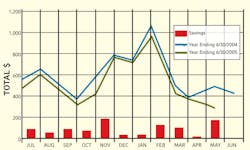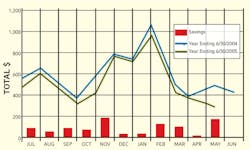Software Helps Battle Soaring Energy Costs
Energy-management software is cutting down on wasted power in many of today's buildings. Providing a growing number of old and new facilities with utility-bill and energy-use tracking, this software is helping facility managers battle soaring energy costs.
Available software packages identify ways to more efficiently manage energy expenditures, including shifting power usage away from peak-load hours and optimizing mechanical equipment, all by aggregating usage patterns and tracking expenses. There are a number of options when it comes to energy-management software, though the most common programs perform interval and/or utility-bill tracking.
Interval tracking is perhaps the simplest way to isolate energy use. Recording usage at 5- to 15-minute intervals, this function allows facility managers to trace usage patterns by tenant or area at any number of meters throughout a building.
Utility-bill tracking typically offers large businesses and government organizations a dashboard for organizing and measuring utility bills. Utilizing a variety of comparison functions, including time of day or year, seasons, individual tenants, etc., this application reveals the energy used or saved over time.
Both interval- and utility-bill-tracking software programs provide a range of features, including sub-meter tracking, standard or customizable reporting, and weather normalization.
Many facilities professionals are interested in energy-management software as a way to uncover tenant energy use. With mounted meters in each tenant space, sub-meter tracking reveals how each group uses power, merging flow rates with energy numbers. "Just by metering, [and] by the pure fact that people know something is being monitored, [you can] save anywhere from 2 to 4 percent," says David Bovankovich, vice president of engineering at Langhorne, PA-based E-Mon. "If you're proactive, you can save [as much as] 10 to 15 percent, depending on the application."
Energy Costs at Lincoln ElementaryOnce usage has been tracked, the way in which it's reported will vary. Less expensive energy-management software comes with standard reporting capabilities, including preprogrammed TIFF or Crystal Reports that feature energy data as collected. The more robust and pricey software, however, permits users to customize their findings, allowing the information and its presentation to be manipulated as desired. Some programs even facilitate the exportation of data into Microsoft Excel. Being armed with the right data allows a facilities manager to "anticipate what needs work before it becomes a major problem or fuel waster," says Dan Margulies, COO at Fresh Meadows, NY-based U.S. Energy Group.
Once reports have been generated, comparing them is another task. According to John Avina, president at San Luis Obispo, CA-based Abraxas Energy Consulting, weather normalization is a crucial feature in evaluating a building's energy savings over time. "You'd think you could just compare last year's bill to this year's bill, but the weather is different every year," says Avina.
Mindi Zissman is a contributing editor at Buildings magazine.

